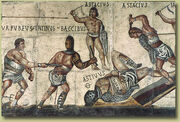- For the category list, see Gladiators. For the category list of gladiator "classes", see Gladiator Types.

Borghese Gladiator Mosaic
Gladiators (Female: gladiatrix) were professional fighters in Ancient Rome, who fought and died for the entertainment of their audience. Gladiators were usually condemned criminals or prisoners of war, set to fight (often to the death) in the Old Arena, and later the Capua Arena. However, not all were of the latter, as free men also volunteered for purposes of personal gain seldom participated. A gladiator that is victorious in his match is awarded coin, rising fame and respect. Fallen gladiators are either put to death by the command of the editor of the game, or sent to the The Pit in shame.
Gladiators were taught the combative skills required at training enterprises called ludi, which were headed by a Lanista. Each gladiator was instructed by a Doctore, whom overseen their training. A gladiator that excels in combat and is continuously victorious in the arena, will rise to become champion of his respective ludus. Gladiators, like most slaves, were branded with a mark, symbolizing what house they belonged to and to whom. This also lead to the development of bonds amongst the gladiators; as they came to see each other as brothers-in-arms.
The social structure of a gladiator is separated into five different ranks as follows: False Gladiator, Gladiator, Veteran Gladiator, Champion, Doctore.
Types of Gladiators[]
Trivia[]
- In Shadow Games, Spartacus fights in the style of Thraex, which represented the Thracian enemies of Rome. Historically however, if Spartacus was indeed a Thracian, Batiatus would have made sure he hadn't fought as a Thraex. This would have been done to avoid stirring up national pride. Similarly, a Greek or Phoenician Gladiator (such as Barca in the series) would have been forbidden from fighting as a Hoplomachus in the Arena.